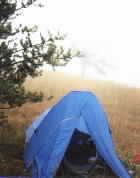 Foggy Morning |
| Here’s my Clip Flashlight tent, and my camp in the morning fog. The upper river had countless huge red and white pine trees. At this camp there were many giant oak trees. |
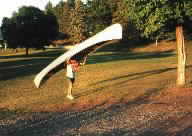 Portage at St. Cloud August 28, 2001 Between Itasca and the Twin Cities, there were a number of dams that required a portage. Most were short but the longest, in Grand Rapids, is nearly 1/2 mile long. Here I am portaging my canoe around the dam in St. Cloud, Minnesota. |
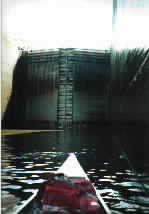 Lock and Dam Upper St. Anthony Falls, Minneapolis Going through the locks was one of the more interesting aspects of the river between Minneapolis and St. Louis. The first, at Upper St. Anthony Falls, has fall of 50 feet! Kind of makes you hope the gate doesn’t fail while you’re inside. The lock numbering is rather confusing. There are locks numbered 1-26, but I don’t think there IS a lock 23, and there IS a lock 5a. There are also two locks without numbers, Upper and Lower St. Anthony Falls. One of the Corps of Engineer fellows told me there was 29 total locks on the river. The biggest downside to the locks and dams for a canoeist is they slow down the river, each one creating a “pool” as they call it. Locking through normally took about 1/2 hour total if I was at the head of the line. Usually I’d be the only boat, but often I’d share the lock with one or more recreational boats. Towboats with barges got preference, which was fair enough. |
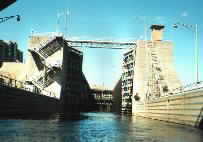 Leaving the Lock A lock is basically a chamber with gates on the upper and lower ends. Once a boat is inside, the chamber is allowed to slowly flood if the boat is going upstream, or in my case, to slowly drain to the level of the lower side. Most boats had radios to alert the lock operator. I had no radio, so I’d pull up to the lock wall and pull a rope. There was a loudspeaker so the operator could let me know that he was going to open the gate, or to give me an idea how long I’d have to wait for the other boats to lock through. If the wait was too long, sometimes I’d portage around. Quite a few times I’d paddle madly for a mile or more trying to lock through with another boat heading downstream. I knew the thrill of victory, and the agony of defeat. |
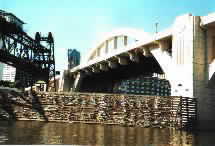 St. Paul Bridges The Twin Cities was the most beautiful urban area I passed through. I especially liked the interesting bridges, including the lines of these bridges located in St. Paul. |
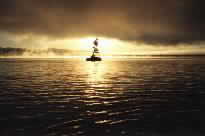 Buoy and Morning Fog Often the river was foggy early in the mornings. The river was usually peaceful, but you had to pay attention! One day I stopped for a quick break on an island, pulling my canoe halfway out of the water on a back corner where it would be out of reach of waves, hopefully. Imagine my chagrin when I returned shortly to find my canoe 100 feet out in the river, and drifting away rapidly. It was hot, and I was wearing my lifejacket, so I quickly took out my valuables and jumped in. Setting out like Michael Phelps, I tried to catch up with my rogue canoe. Unfortunately, there was a (seemingly) rare downriver wind, and I’d flipped up the cover of my cooler to further increase the sail effect. After about 5 minutes, it was clear I was being outdistanced. I headed for shore, and hoped I could flag down a boat before all my worldly belongings were crushed by a 25,000 ton raft of barges. Minutes later, a boat came roaring down the river. I’d left my glasses, so I couldn’t tell if they had spotted my frantically waved life jacket. But they had, and soon were towing my canoe back up. Seems they had seen my canoe washed off the shore from their towboat. They’d quickly launched their small boat to rescue me, while the towboat kept on its course. I thanked them profusely, but I’ve got a feeling I made their day, too! |
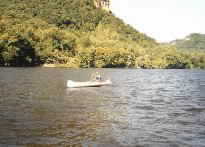 Crossing Lake Pepin People often picture the Mississippi as a madhouse of water traffic. Usually, it wasn’t, but it certainly WAS during Labor Day Weekend on Lake Pepin! In addition there was an unusually stiff headwind and substantial waves that day. |
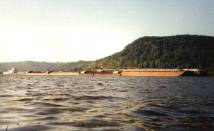 Raft of Barges How much barge traffic was there? Sometimes I could look up and down the river and see 4 or more rafts of barges, but often I wouldn’t see any for many hours. The amount of power it took to move those enormous rafts is breathtaking. One barge can carry as much as 60 18-wheelers! I saw one raft of 42 barges (the one shown has 15)! So how dangerous were they? It’s sort of like crossing a busy highway on foot. If you don’t pay attention, it’s very dangerous, but if you do, the danger is minimal. They’d throw off a pretty decent wake sometimes, but I it didn’t prove to be a serious problem. |
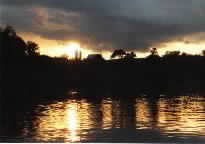 Iowa Farm on River Bluff On the upper river there was plenty of camping areas designated by the Minnesota DNR. After the Twin Cities there were lots of nice islands to camp on, clear down to St. Louis. Many were created originally by river dredging. Here’s a view of an Iowa farm from one of my island camps. |




Hi Bruce,
I am planning a trip of my own down the lowere river portion of the mississippi this summer, but I am having difficulty finding good maps. Do you have any links or ideas that could help me?
Thanks,
Jack
Hi Jack,
I have links to maps, here: https://bucktrack.com/Mississippi_Canoe_Planning.html
Good luck on your trip!
Buck
WOW! That sounds so great.